Katavi National Park is a remote and untouched wilderness located in western Tanzania, renowned for its abundant wildlife and pristine natural landscapes. Covering an area of approximately 4,471 square kilometers, Katavi is one of the largest and least visited national parks in Tanzania, offering a secluded and exclusive safari experience for adventurous travelers.
Geography and Terrain
The park is characterized by vast floodplains, seasonal lakes, and dense woodlands, creating a diverse habitat for a wide range of wildlife. The Katuma River and seasonal streams flow through the park, attracting large herds of elephants, buffaloes, and hippos during the dry season. The park’s terrain includes open grasslands, miombo woodlands, and palm-fringed lakeshores, providing picturesque scenery and abundant opportunities for wildlife viewing.
Wildlife
Katavi National Park is renowned for its impressive concentrations of wildlife, especially during the dry season (June to October). Key species found in the park include:
- Elephants: Large herds of elephants gather around the Katuma River and seasonal water sources.
- Buffaloes: Massive herds of buffaloes roam the grasslands and woodlands, often seen in close proximity to lions and other predators.
- Lions: Katavi is home to a healthy population of lions, known for their impressive hunting skills and social behaviors.
- Hippos and Crocodiles: The park’s rivers and lakes support thriving populations of hippos and Nile crocodiles.
- Birdlife: Katavi is a birdwatcher’s paradise, with over 400 species recorded, including waterbirds, raptors, and migratory species.
Activities and Attractions
Visitors to Katavi National Park can enjoy a range of activities designed to explore its wildlife and natural beauty:
- Game Drives: Explore the park on guided game drives, offering opportunities to observe wildlife up close in their natural habitat.
- Walking Safaris: Guided walking safaris provide a more intimate experience, allowing visitors to explore the park on foot and learn about its flora and fauna.
- Bird Watching: Katavi’s diverse habitats attract a wide variety of bird species, making it an ideal destination for bird enthusiasts.
- Photography: Capture stunning wildlife and landscape photographs against the backdrop of Katavi’s dramatic scenery and golden light.
Conservation and Sustainability
Conservation efforts in Katavi National Park focus on protecting its diverse ecosystems and wildlife populations. Anti-poaching patrols, habitat restoration projects, and community engagement initiatives play crucial roles in ensuring the park’s long-term sustainability. Sustainable tourism practices are promoted to minimize the environmental impact of visitor activities while supporting local communities and promoting conservation awareness.
Visitor Experience
Katavi National Park offers a unique and off-the-beaten-path safari experience for travelers seeking to explore Tanzania’s wild and remote landscapes. The park’s secluded location and limited visitor numbers ensure a peaceful and exclusive wildlife viewing experience, far from the crowds found in more popular safari destinations. Accommodation options range from tented camps to rustic lodges, providing comfortable amenities amidst the untamed wilderness. Whether observing elephants along the Katuma River, tracking lions on the savannah, or witnessing breathtaking sunsets over the vast floodplains, visitors to Katavi National Park are immersed in a truly authentic African safari adventure.














